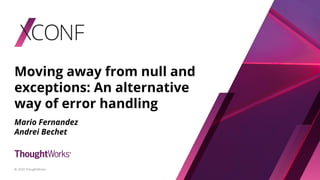
Error handling
- 1. Moving away from null and exceptions: An alternative way of error handling Mario Fernandez Andrei Bechet © 2020 ThoughtWorks
- 2. What to expect © 2020 ThoughtWorks
- 3. The two takeaways © 2020 ThoughtWorks
- 4. Let’s stop using null © 2020 ThoughtWorks
- 5. Let’s stop abusing exceptions © 2020 ThoughtWorks
- 6. Some Context © 2020 ThoughtWorks
- 10. Did you have a NullPointerException lately in a production system? © 2020 ThoughtWorks
- 12. public static boolean isAdmin(List<Scope> scopes) { if(scopes == null) { return false; } Scope adminScope = findAdminScope(scopes); if(adminScope == null) { return false; } return adminScope.isValid(); }
- 13. Ad-hoc Error Handling and it pollutes © 2020 ThoughtWorks
- 14. Null values sidestep the type system © 2020 ThoughtWorks
- 15. Runtime instead of compile time feedback © 2020 ThoughtWorks
- 16. Nullable Types © 2020 ThoughtWorks
- 17. Authorization: Bearer bGciOi...JIUzI1NiIs fun String.extractToken(): String? = if (startsWith("Bearer")) split(" ").last() else null
- 18. header.extractToken() ?.let { token -> doStuff(token) }
- 19. What about more complex flows © 2020 ThoughtWorks
- 20. Get Authorization header Extract Token Verify Token Set Security Context Null?
- 21. request.getHeader(Headers.AUTHORIZATION) ?.let { header -> header.extractToken() ?.let { jwt -> verifier.verify(jwt) ?.let { token -> SecurityContextHolder.getContext().authentication = token } } }
- 22. Data Types A digression about Functional Programming © 2020 ThoughtWorks
- 23. A data type is an abstraction that encapsulates one reusable coding pattern © 2020 ThoughtWorks
- 24. Think of containers holding your data © 2020 ThoughtWorks
- 25. Provide clear semantics and an interface to manipulate the data © 2020 ThoughtWorks
- 26. Option Either Validated IO Examples © 2020 ThoughtWorks
- 29. A value that might be absent © 2020 ThoughtWorks
- 31. sealed class Option<out T> { data class Some<out T>(val a: T): Option<T>() object None: Option<Nothing>() }
- 32. How to use it? © 2020 ThoughtWorks
- 33. fun String.extractToken(): Option<String> = startsWith("Bearer ") .maybe { split(" ").last() }
- 34. when (val token = header.extractToken()) { is Option.None -> ResponseEntity.status(401).build() is Option.Some -> ResponseEntity.ok(result.t) }
- 35. A container is not just a holder of data © 2020 ThoughtWorks
- 36. interface Operations { fun <A, B> Option<A>.map(f: (A) -> B): Option<B> fun <A, B> Option<A>.flatMap(f: (A) -> Option<B>): Option<B> }
- 37. Exceptions The hidden GOTO © 2020 ThoughtWorks
- 38. Did you get a 500 lately in a production system? © 2020 ThoughtWorks
- 39. … pretty common to throw © 2020 ThoughtWorks
- 41. At first Exceptions may sound like a good idea © 2020 ThoughtWorks
- 42. … but they easily lead to bad decisions © 2020 ThoughtWorks
- 44. Easy to ignore or miss © 2020 ThoughtWorks
- 45. Exceptions oftenly end up being used as flow control © 2020 ThoughtWorks
- 46. Breaks encapsulation © 2020 ThoughtWorks
- 47. © 2020 ThoughtWorks Controller API clientService layer Happy path Error path Happy path
- 48. interface Verifier { /** * @param jwt a jwt token * @return authentication credentials */ fun verify(jwt: String): TokenAuthentication } © 2020 ThoughtWorks
- 49. /** * Perform the verification against the given Token * * @param token to verify. * @return a verified and decoded JWT. * @throws AlgorithmMismatchException * @throws SignatureVerificationException * @throws TokenExpiredException * @throws InvalidClaimException */ public DecodedJWT verifyByCallingExternalApi(String token);
- 50. A typical way of handling this © 2020 ThoughtWorks
- 51. @ExceptionHandler(JWTVerificationException::class) fun handleException(exception: JWTVerificationException): ResponseEntity<ErrorMessage> { return ResponseEntity .status(HttpStatus.BAD_GATEWAY) .body(ErrorMessage.fromException(exception)) }
- 52. What is an Exception? © 2020 ThoughtWorks
- 53. A cluster going down 🔥 is an exception © 2020 ThoughtWorks
- 54. Not really an exception © 2020 ThoughtWorks
- 55. As the context grows it becomes harder to test and reason about © 2020 ThoughtWorks
- 57. Two different values depending on the result of the computation © 2020 ThoughtWorks
- 59. sealed class Either<out L, out R> { data class Left<out L, out R>(val a: L) : Either<L, R>() data class Right<out L, out R>(val b: R) : Either<L, R>() }
- 60. How to use it? © 2020 ThoughtWorks
- 61. interface Verifier { fun verify(token: String): Either<TokenEx, TokenAuth> }
- 62. fun Verifier.unsafeVerify(jwt: String): Either<TokenEx, TokenAuth> = try { verifyByCallingExternalApi(jwt).right() } catch (e: JWTVerificationException) { e.left() }
- 63. An evolving computation © 2020 ThoughtWorks
- 64. interface Operations { fun <T, A, B> Either<T, A>.map(f: (A) -> B): Either<T, B> fun <T, A, B> Either<T, A>.flatMap(f: (A) -> Either<T, B>): Either<T, B> }
- 66. What about more complex flows © 2020 ThoughtWorks
- 67. Get Authorization header Extract Token Verify Token Set Security Context Null?
- 68. request.getHeader(Headers.AUTHORIZATION) .toEither() .flatMap { header -> header.extractToken() .flatMap { jwt -> verifier .verify(jwt) .map { token -> SecurityContextHolder.getContext().authentication = token } } }
- 69. Non-Nested Syntax © 2020 ThoughtWorks
- 70. Similar to async/await © 2020 ThoughtWorks
- 71. Either.fx { val (header) = request.getHeader(Headers.AUTHORIZATION).toEither() val (jwt) = header.extractToken() val (token) = verifier.verify(jwt) SecurityContextHolder.getContext().authentication = token }
- 72. thoughtworks.com/insights/blog/either-data-type-alternative-throwing-exceptions © 2020 ThoughtWorks
- 74. Null and exceptions can lead to flaky, hard to understand code © 2020 ThoughtWorks
- 75. Let’s stop using null © 2020 ThoughtWorks
- 76. Let’s stop abusing exceptions © 2020 ThoughtWorks
- 77. Continue the conversation on Slack © 2020 ThoughtWorks XConfEurope2020 xconfeurope2020.slack.com #talk4-alternative-to-null-and-exceptions #XConfOnline
